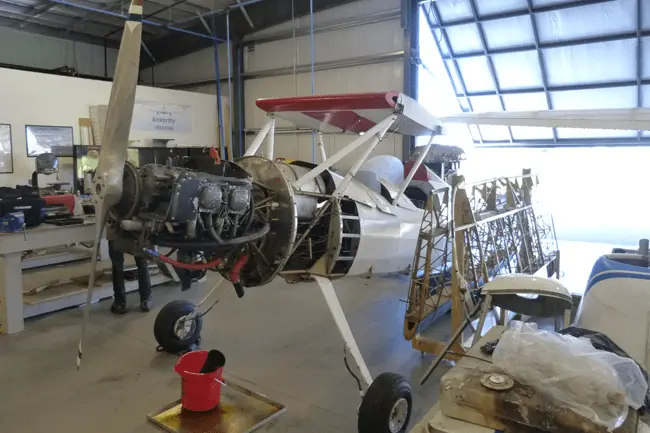Next generation of aviation mechanics prepares to take flight
08/07/2017| Daniel Leaderman
Article Topics:
Next generation of aviation mechanics prepares to take flight
08/07/2017 | Daniel Leaderman
Aviation industry experts warn that a "perfect storm" is coming: a growing industry and an aging workforce is expected to create a shortage of aircraft maintenance technicians – as many as 35,000 of them per year, by some reckonings.
Where will the industry find these new technicians? In Maryland, at least, they're in Washington County. At the Pittsburgh Institute of Aeronautics (PIA), to be precise.
Don't let the name fool you; the nonprofit institution's Hagerstown branch is the only facility in Maryland that offers the Federal Aviation Administration's Airframe and Powerplant Certification, or A&P, for short. Generally speaking, all mechanical work done on an aircraft must be verified by a certified A&P technician (there are some exceptions for the military and for experimental aircraft).
The 16-month certificate program PIA offers in Hagerstown is designed "to get individuals out into the workforce as quickly as possible," said Roxanne Ober, PIA's director of admissions and outreach. Although not long in duration, the program is intensive, she said.
"If you're late a minute, you make up that minute," Ober said. "You wouldn't want anyone working on your aircraft who didn't go through the entire course of instruction."
With the workforce shortage looming, airlines are forming relationships with airline maintenance schools so they can keep their technical jobs filled. Delta Air Lines recently partnered with several dozen institutions, including PIA's locations in Hagerstown and Pittsburgh, to meet its demand for technicians, and Piedmont Airlines, a Salisbury-based subsidiary of American Airlines, has been one of the Hagerstown branch's biggest recruiters.
"We have a number of [PIA] alums in senior management," said Kevin Dallaire, recruiter for Piedmont Airlines. "They know they received a great education and have a lot of confidence in their alma mater."
PIA's history can be traced back to the earliest days of aviation; it began in 1929 as an offshoot of Curtiss-Wright Flying Services – a company co-founded by Orville Wright of the Wright brothers. The institute's curriculum covers aviation design and technology that dates back just as far. For example, students learn to make airplane wings with a cloth exterior – rather than, say, aluminum or carbon fiber – a technique that dates back more than a century.
"We teach everything, from the Wright Brothers' days all the way up," said PIA instructor Stephen Smith, who noted that while car mechanics might not need to know much about the original Ford Model-T, aviation mechanics are likely to encounter a broad range of aircraft, from commercial airliners to private jets to restored, World War II-era fighters.
"Everything is still out there. It's very different from most other industries," Smith said. "We don't have any idea where [the students] are going to go to or gravitate toward over the years, so it's a requirement that they know a little bit of everything."
If you walk into the hangar at the institute's Hagerstown facility, "a little bit of everything" is just what you'll see: airplane wings that have been damaged and repaired over and over again; various engines for students to disassemble and reassemble; even an entire small helicopter. It's here that the students get the bulk of their hands-on training for both the airframe (essentially, the outside of the plane such as the wings and fuselage) and powerplant (engines and electrical systems) portions of their education.
Students must also learn to taxi (but not fly) an aircraft, which is why it's important that PIA is located on the grounds of the Hagerstown Regional Airport.
The skills students learn here aren't limited to the aviation industry; some have gone into other fields like robotics, farming and construction equipment, and the railroad industry, Ober said. But staying in aviation is certainly lucrative: the median salary for aircraft and avionics mechanics and technicians is over $60,000 per year.
For PIA student Ivey Rutherford, the institute's certificate program was a way to take more control of her future and her education. Rutherford initially contemplated going into the military, where she hoped to work on helicopters, but was ultimately drawn to the institute because she wanted more control of where she would travel over the course of her career.
"I love it," said Rutherford, 24, who relocated to Hagerstown from Fredericksburg, Virginia to get her certificate. "I love the hands-on aspect of the program." The focus and relative brevity of the PIA curriculum also appealed to that pursuing a college degree, which would require her to also take additional courses like English that didn't appeal to her; this way, she's just learning what she wants to learn, she said.
Twenty-year-old Ryan Hall's plan is almost the inverse of Rutherford's: he sees PIA as a cost-effective way to earn some credits that he can later transfer to a bachelor's degree in engineering. The Fayetteville, Pa. resident said his ultimate goal is to join the U.S. Air Force.
The institute also prides itself on being veteran-friendly; many veterans may have experience working on military aircraft, but still need the FAA certification to transfer those skills into a civilian career.
"Aircraft [maintenance] is going to be a booming field here soon because of all the people who are going to be retiring," said Matt Luning, 36, who came to PIA after 10 years in the U.S. Army, where he worked as a military police officer. "They need some young blood."
Keep up with the latest.
Sign up for e-mail notifications.
